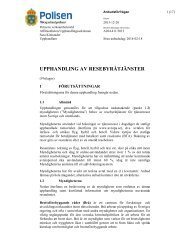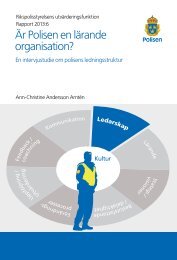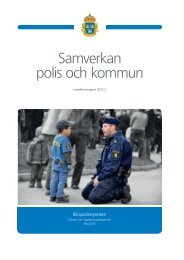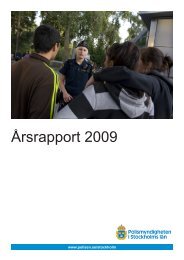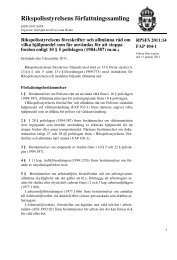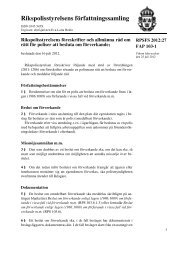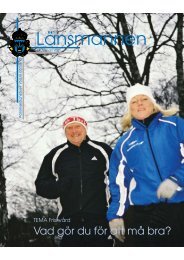Trafficking in human beings for sexual and other purposes - Polisen
Trafficking in human beings for sexual and other purposes - Polisen
Trafficking in human beings for sexual and other purposes - Polisen
- No tags were found...
You also want an ePaper? Increase the reach of your titles
YUMPU automatically turns print PDFs into web optimized ePapers that Google loves.
3. Crim<strong>in</strong>al Development123. Crim<strong>in</strong>al Development3.1 <strong>Traffick<strong>in</strong>g</strong> <strong>in</strong> <strong>human</strong> be<strong>in</strong>gs <strong>for</strong> <strong>sexual</strong><strong>purposes</strong>The National Bureau of Investigation regularlyreceives <strong>in</strong><strong>for</strong>mation about groups <strong>and</strong> <strong>in</strong>dividualsresponsible <strong>for</strong> various <strong>for</strong>ms of <strong>human</strong> traffick<strong>in</strong>gwith<strong>in</strong>, through <strong>and</strong> <strong>in</strong>to Sweden. This <strong>in</strong><strong>for</strong>mation isprovided by bodies such as the Swedish <strong>and</strong> <strong>for</strong>eignpolice, NGOs, the general public <strong>and</strong> the SwedishMigration Board. In<strong>for</strong>mation, <strong>and</strong> the prelim<strong>in</strong>ary<strong>in</strong>vestigations undertaken dur<strong>in</strong>g 2011, show that<strong>human</strong> traffick<strong>in</strong>g is not just a metropolitan phenomenonbut also occurs <strong>in</strong> smaller towns throughoutSweden.Accord<strong>in</strong>g to the Swedish National Police Board itis difficult to estimate how many people fell victim to<strong>human</strong> traffick<strong>in</strong>g <strong>in</strong> Sweden dur<strong>in</strong>g 2011. The numberof victims of <strong>human</strong> traffick<strong>in</strong>g identified <strong>in</strong> Swedenlargely depends on the resources which the policeput <strong>in</strong>to detect<strong>in</strong>g this crime <strong>and</strong> on the experience<strong>and</strong> competence that exists with<strong>in</strong> the police organisation.The level of these <strong>in</strong>itiatives varies betweenpolice authorities <strong>and</strong> can vary from one year toan<strong>other</strong>. It is not possible to identify or even to locateall of the victims, ma<strong>in</strong>ly girls <strong>and</strong> women, mentioned<strong>in</strong> tapped telephone calls or observed dur<strong>in</strong>g policesurveillance. Neither can the estimate be based exclusivelyon the number of victims that are viewed as<strong>in</strong>jured parties <strong>in</strong> <strong>human</strong> traffick<strong>in</strong>g <strong>in</strong>vestigations,s<strong>in</strong>ce the majority of these <strong>in</strong>vestigations result <strong>in</strong> sentences<strong>for</strong> procur<strong>in</strong>g/aggravated procur<strong>in</strong>g. Thesequence of events <strong>in</strong> a procur<strong>in</strong>g case can exhibitvery great similarities to the sequence of events <strong>in</strong> a<strong>human</strong> traffick<strong>in</strong>g case. The crucial issue <strong>in</strong> determ<strong>in</strong><strong>in</strong>gwhether it might be possible to prosecute theperpetrators <strong>and</strong> convict them of <strong>human</strong> traffick<strong>in</strong>g<strong>and</strong> not <strong>for</strong> procur<strong>in</strong>g, is whether the victim’s libertyhas been violated.There may be several explanations <strong>for</strong> why themajority of cases brought to trial result <strong>in</strong> convictions<strong>for</strong> procur<strong>in</strong>g/aggravated procur<strong>in</strong>g <strong>in</strong>stead of<strong>human</strong> traffick<strong>in</strong>g. It may be because the <strong>human</strong>traffick<strong>in</strong>g legislation is still complex <strong>and</strong> difficult toapply. In addition, <strong>in</strong> recent years, the perpetratorshave changed their modi oper<strong>and</strong>i <strong>in</strong> certa<strong>in</strong> cases.Instead of us<strong>in</strong>g violence <strong>and</strong> threats aga<strong>in</strong>st the victim,the perpetrators often make offers of “betterconditions”, such as greater freedom of action. Thevictims are also allowed to reta<strong>in</strong> a larger proportionof their earn<strong>in</strong>gs. This is an effective way of gett<strong>in</strong>gthe victims tied <strong>in</strong> <strong>and</strong> mak<strong>in</strong>g them dependent,result<strong>in</strong>g <strong>in</strong> the victims rema<strong>in</strong><strong>in</strong>g loyal to the perpetrators<strong>and</strong> be<strong>in</strong>g less <strong>in</strong>cl<strong>in</strong>ed to act as witnessesaga<strong>in</strong>st them. It can sometimes be difficult to get thecourts to underst<strong>and</strong> how serious the oppression hasbeen when the women have not been treated “particularlybadly”. A change <strong>in</strong> the perpetrators’behaviour became apparent <strong>in</strong> 2011, when two majorprelim<strong>in</strong>ary <strong>in</strong>vestigations, one <strong>in</strong> Stockholm <strong>and</strong>one <strong>in</strong> Västra Götal<strong>and</strong>, also encompassed threatened<strong>and</strong> actual physical <strong>and</strong> <strong>sexual</strong> violence aga<strong>in</strong>stthe victims.In 2011, the police drew up 35 reports relat<strong>in</strong>g to<strong>human</strong> traffick<strong>in</strong>g <strong>for</strong> <strong>sexual</strong> <strong>purposes</strong>. Dur<strong>in</strong>g thatsame year, two people were convicted <strong>for</strong> <strong>human</strong> traffick<strong>in</strong>g<strong>for</strong> <strong>sexual</strong> <strong>purposes</strong>. In addition, three peoplewere sentenced <strong>for</strong> aggravated procur<strong>in</strong>g <strong>and</strong> eight<strong>for</strong> procur<strong>in</strong>g that had been of a <strong>human</strong> traffick<strong>in</strong>gnature. F<strong>in</strong>ally 450 legal proceed<strong>in</strong>gs were <strong>in</strong>itiatedconcern<strong>in</strong>g the purchase of <strong>sexual</strong> services <strong>and</strong> 7 legalproceed<strong>in</strong>gs concern<strong>in</strong>g the purchase of <strong>sexual</strong> actsfrom children under the age of 18 7 . More prelim<strong>in</strong>ary<strong>in</strong>vestigations <strong>in</strong>to <strong>human</strong> traffick<strong>in</strong>g, procurement<strong>and</strong> purchase of <strong>sexual</strong> services are ongo<strong>in</strong>g, onwhich rul<strong>in</strong>gs are expected to be pronounced <strong>in</strong> 2012.The above statistics can be compared to the situationdur<strong>in</strong>g 2010 when 32 reports were drawn up concern<strong>in</strong>g<strong>human</strong> traffick<strong>in</strong>g <strong>for</strong> <strong>sexual</strong> <strong>purposes</strong>. Inthat same year, three people were sentenced <strong>for</strong> complicity<strong>in</strong> <strong>human</strong> traffick<strong>in</strong>g <strong>for</strong> <strong>sexual</strong> <strong>purposes</strong> <strong>and</strong>7 Total judicial decisions, orders of summary punishment <strong>and</strong>waivers of prosecution <strong>in</strong> 2011.




